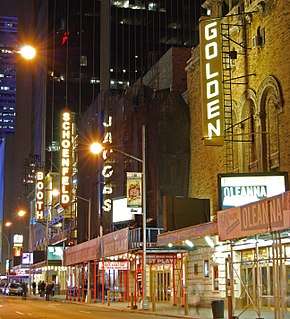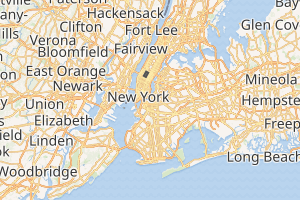Theater District, Manhattan
New York City's Theater District (sometimes spelled Theatre District, and officially zoned as the "Theater Subdistrict"[2]) is an area in Midtown Manhattan where most Broadway theaters are located, as well as many other theaters, movie theaters, restaurants, hotels, and other places of entertainment. It is bounded by West 40th Street on the south, West 54th Street on the north, Sixth Avenue on the east and Eighth Avenue on the west, and includes Times Square. The Great White Way is the name given to the section of Broadway which runs through the Theater District.
Theater District | |
|---|---|
Neighborhood of Manhattan | |
 The Golden Theatre, Bernard B. Jacobs Theatre, Gerald Schoenfeld Theatre and Booth Theatre on West 45th Street in Manhattan's Theater District | |

Location in New York City | |
| Coordinates: 40.759°N 73.985°W | |
| Country | United States |
| State | New York |
| City | New York City |
| Borough | Manhattan |
| Zip code | 10018, 10019, 10036[1] |
| Area codes | 212, 332, 646, and 917 |
It also contains recording studios, record label offices, theatrical agencies, television studios, restaurants, Duffy Square, Shubert Alley, the Brill Building, a Ripley's Believe It or Not! Odditorium, and Madame Tussauds New York.[3][4][5]
Boundaries
The City of New York defines the subdistrict for zoning purposes to extend from 40th Street to 57th Street and from Sixth Avenue to Eighth Avenue, with an additional area west of Eighth Avenue from 42nd Street to 45th Street.[6] The Times Square Alliance, a Business Improvement District organization dedicated to improving the Theater District, defines the district as an irregularly shaped area within the bounding box of 40th Street, 6th Avenue, 53rd Street, and 9th Avenue.[7] As of 2018, the Vivian Beaumont Theater (part of Lincoln Center) is the only Broadway-class theater not located in the Theater District.
History
Origins and early history
In 1836, mayor Cornelius Lawrence opened 42nd Street to encourage the city's northern expansion, saying "move up town and enjoy the pure, clean air".[8] The Theater District began attracting theaters and restaurants after the Metropolitan Opera House moved to West 39th Street and Broadway in 1883.[9] Oscar Hammerstein I opened his Victoria Theatre on 42nd Street in 1899.[8] Accessibility to the Theater District improved as electrified trolley lines started in 1899, followed by the opening of the New York City Subway's first line in 1904.[8]
"The Great White Way" is a nickname for a section of Broadway in Midtown Manhattan that encompasses the Theater District. In 1880, Broadway between Union Square and Madison Square was illuminated by Brush arc lamps, making it among the first electrically lighted streets in the United States.[10] By the 1890s, 23rd Street to 34th Street was so brightly illuminated by electrical advertising signs people began calling it "The Great White Way".[11] As the theater district shifted uptown just before the turn of the century, the nickname stuck and became synonymous.[12]
Over the years, the district has been referred to by New Yorkers as "the Rialto," "The Main Stem," and "Broadway." Around the turn of the 20th century, it was simply called "The Street".[13][14]
By the 1970s, 42nd Street was seedy and run-down; X-rated movie houses, peep shows, and so-called grind houses began to locate there. It was considered by some New Yorkers as a somewhat dangerous place to venture. However, in the 1990s the entire area was significantly revitalized by the city. Most of the adult theater businesses closed and an array of new theaters, multiplex movie houses, restaurants, and tourist attractions opened.[4]
In 1974, the Lyceum Theatre became the first Broadway theatre to receive the landmark status designation from the New York City Landmarks Preservation Commission.[12]
Joe Papp's "Save the Theatres" campaign
In the Spring of 1982, Joseph Papp, the Broadway theatrical producer, and director who had established The Public Theater, led a campaign called "Save the Theatres" in Manhattan.[15] The primary initial goal of the "Save the Theatres" effort, which was sponsored by Papp's not-for-profit group and supported by the Actors Equity union, was to save several theater buildings in the Theatre District neighborhood from their impending demolition by monied Manhattan development interests.[16][17][18][19] Papp provided financial resources, campaign buttons, posters, and newspaper ads for the effort; recruited a publicist and actors to promote the cause; and provided a various stage and street venues for public events in support of the campaign for saving the historic theatres.[17]
At Papp's behest, in July 1982, U.S. Representative Donald J. Mitchell of New York, and 13 co-sponsors,[lower-alpha 1] introduced a bill entitled "A bill to designate the Broadway/Times Square Theatre District in the City of New York as a national historic site" (H.R. 6885).[21] The proposed legislation, which was not enacted, would have required the Federal Government to aid financially and otherwise in preserving the district and its historic theatre houses as an official National Historic Site.[21]
The Save the Theatres campaign then turned their efforts toward supporting the establishment of the Theater District as a registered New York City historic district.[22][23] In December 1983, Save the Theatres prepared "The Broadway Theater District, a Preservation Development and Management Plan," and demanded that each theater in the district receive landmark designation.[23] Mayor Koch ultimately responded by creating a Theater Advisory Council, that included Papp as a member,[17] and which eventually led to the area being officially zoned as the "Theater Subdistrict."[2]
Theater Subdistrict zoning
In January 2001, the New York Appellate Division, First Department in Fisher v. Giuliani, partially upheld the 1998 expansion of the Theater Subdistrict zoning regulations, which added receiving sites along Eighth Avenue where development rights from the landmarked Broadway theaters could be sold. Community and civic organizations opposed the expansion of the district as it would impinge the nearby residential neighborhood of Hell's Kitchen/Clinton. The court objection, filed in 1999, did not challenge the pre-existing Theater Subdistrict itself or the original development rights zoning legislation.[24]
Under the 1998 zoning regulation, New York City also created the Theater Subdistrict Council (TSC), a not-for-profit corporation.[25] The TSC administers the Theater Subdistrict Fund and allocates grants.[25]
The New York City Zoning Resolution for special purpose districts, as amended on April 30, 2012, contains special regulations for the Theater Subdistrict, including the transfer of development rights, incentives for the rehabilitation of existing theaters, the creation of a theater council to promote theaters, and zoning and signage for theaters, and contains a list of theaters that qualify for special provisions in the regulations.[26]
Other nearby theater areas
The area known as Theatre Row is an area on 42nd Street from Ninth Avenue to Eleventh Avenue, which includes many Off-Broadway and Off-Off-Broadway theaters.
Points of interest
- Statue of Francis P. Duffy by Charles Keck (Duffy Square, Times Square)
- Statue of George M. Cohan by Georg John Lober and architect Otto Langman (Duffy Square, Times Square)
See also
|
|
References
Informational notes
- Co-sponsors of the Mitchell bill included: Rep. Michael D. Barnes (MD), Rep. Barber B. Conable, Jr. (NY), Rep. Thomas A. Daschle (SD), Rep. Arlen Erdahl (MN), Rep. David W. Evans (IN), Rep. Hamilton Fish, Jr. (NY), Rep. Thomas M. Foglietta (PA), Rep. Peter A. Peyser (NY), Rep. Peter W. Rodino, Jr. (NJ), Rep. Louis Stokes (OH), Rep. Ted Weiss (NY), Rep. George C. Wortley (NY), and Rep. Ron Wyden (OR).[20]
Notes
- "New York Zip Code Boundary Map (NY)". Zipmap.net. Retrieved February 26, 2013.
- "New York City Department of City Planning". NYC.gov. Archived from the original on March 14, 2013. Retrieved March 3, 2013.
- Editors of Time Out (2011). Time Out New York. Time Out Guides. Retrieved February 26, 2013.CS1 maint: extra text: authors list (link)
- Eleanor Berman (2013). Top 10 New York City. Penguin. Retrieved February 28, 2013.
- Sascha Zuger (2011). Moon New York State. Avalon Travel. Retrieved February 28, 2013.
- "Special Purpose Districts: Manhattan: Special Midtown Districts" on the official NYC website. Accessed: February 21, 2013
- Times Square: Times Square/Theater District Dining
- "Broadway History". Spotlight on Broadway. Retrieved June 15, 2018.
- AnneLise Sorensen, Eleanor Berman (2012). DK Eyewitness Travel Guide: New York City. Penguin. Retrieved February 26, 2013.
- Burrows & Wallace 1999, p. 1063.
- Burrows & Wallace 1999, p. 1066.
- Jaramillo, Carina (August 8, 2016). "History of Theater on Broadway". Octane Seating.
- Irving L. Allen (1995). City In Slang: New York Life and Popular Speech. Oxford University Press. Retrieved March 3, 2013.
- William R. Taylor (April 22, 1996). Inventing Times Square: Commerce and Culture at the Crossroads of the World. JHU Press. Retrieved March 3, 2013.
- The name of the organization was "Save the Theatres, Inc., as noted in court papers. See Shubert Organization, Inc. v. Landmarks Preservation Commission of the City of New York and Save the Theatres, Inc. Archived May 21, 2013, at the Wayback Machine, Supreme Court of New York, Appellate Division, First Department, May 16, 1991, accessed March 10, 2013
- "Proposal to Save Morosco and Helen Hayes Theaters", LHP Architects, accessed March 10, 2013
- Helen Epstein (1994). Joe Papp: An American Life. p. 403. Retrieved February 22, 2013.
- "City Panel Near Vote On Save-The-Theaters Proposals". New York City: NYTimes.com. April 15, 1984. Retrieved February 22, 2013.
- Corwin, Betty "Theatre on film and tape archive" Archived September 21, 2013, at the Wayback Machine, International Association of Libraries and Museums of the Performing Arts, accessed May 10, 2013
- Bill Summary & Status – 97th Congress (1981–1982) – H.R.6885 - Co-Sponsors Thomas.loc.gov. Retrieved December 10, 2015
- "H.R.6885 - A bill to designate the Broadway/Times Square Theatre District in the City of New York as a national historic site, and for other purposes.". Bill of July 27, 1982. Retrieved December 10, 2015.
- Lynne B. Sagalyn (2003). Times Square Roulette: Remaking the City Icon. MIT Press. Retrieved February 26, 2013.
- Peter Bosselmann (August 28, 1985). Representation of Places – Imprimé: Reality and Realism in City Design. Retrieved February 26, 2013.
- Fisher v. Giuliani, 280 A.D.2d 13, 720 (N.Y.S.2d 2001).
- "Theater Subdistrict Council – New York City Department of City Planning". Nyc.gov. Archived from the original on March 14, 2013. Retrieved February 22, 2013.
- "The City of New York Zoning Resolution; Article VIII; Chapter 1;" (PDF). Mayor Bloomberg; New York City Planning Commission; Department of City Planning. May 25, 2012. Retrieved February 25, 2013.
Bibliography
- Burrows, Edwin G. & Wallace, Mike (1999). Gotham: A History of New York City to 1898. New York: Oxford University Press. ISBN 0-195-11634-8.
Further reading
- Bianco, Anthony (2004). Ghosts of 42nd Street: A History of America's Most Infamous Block. New York: HarperCollins Books, ISBN 0-688-17089-7. A detailed history that focuses primarily of the Times Square Theater District from the beginning of the 20th century through its successful revival/restoration in the late 20th century.
External links
- NYC.com Visitor Guide: Theater District (official site of New York City)
- Theater District Dining (official site of Times Square)